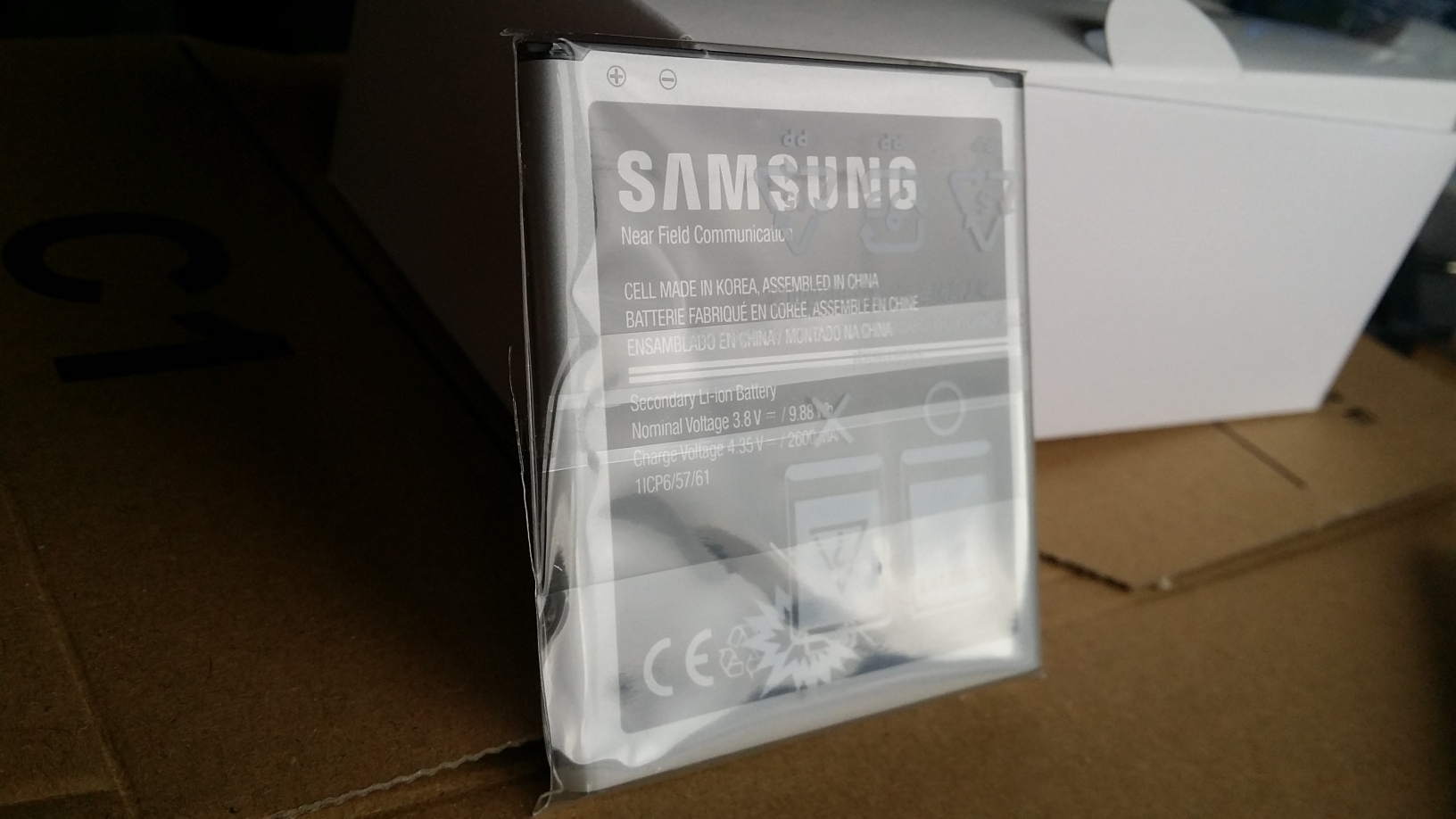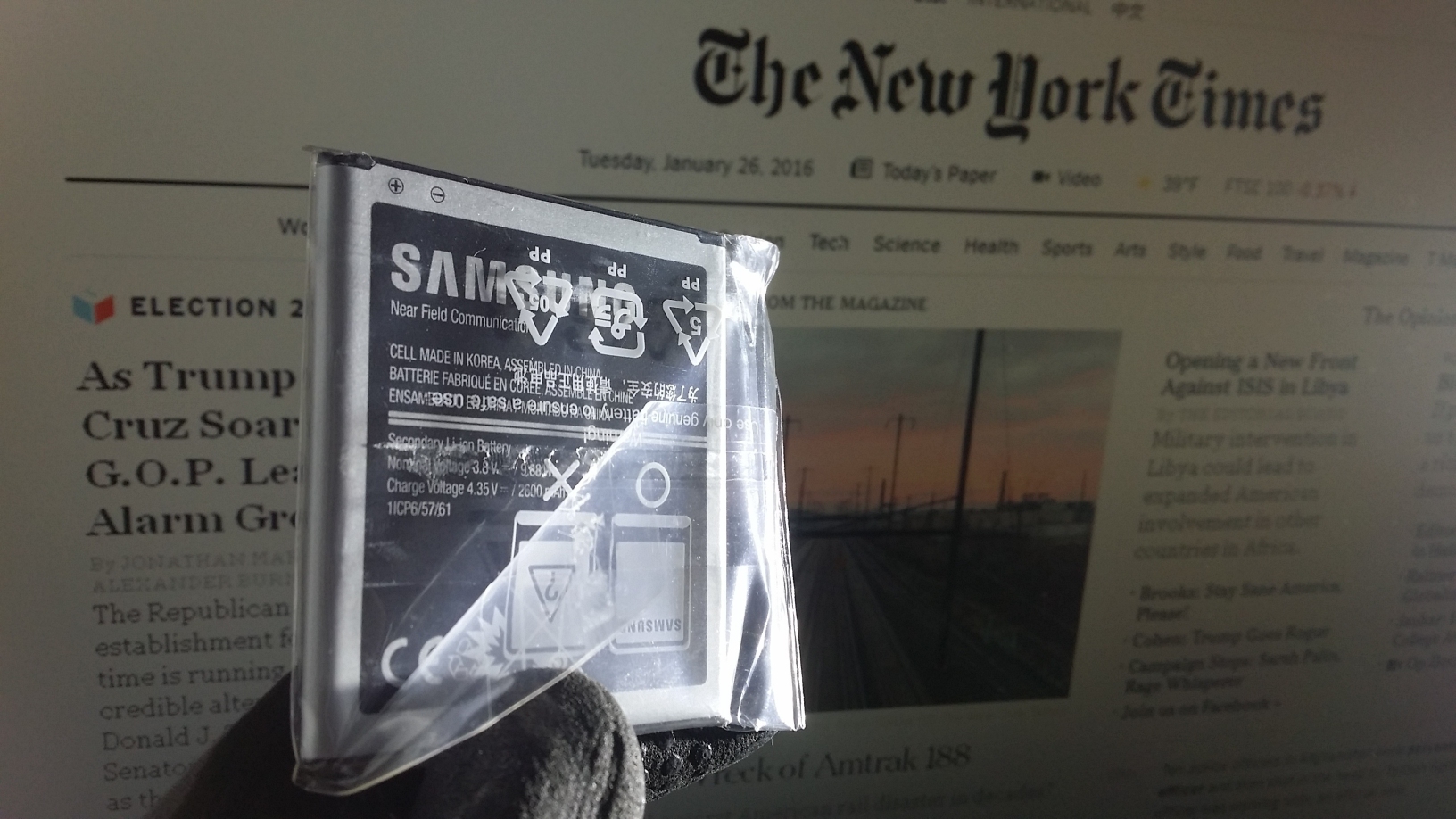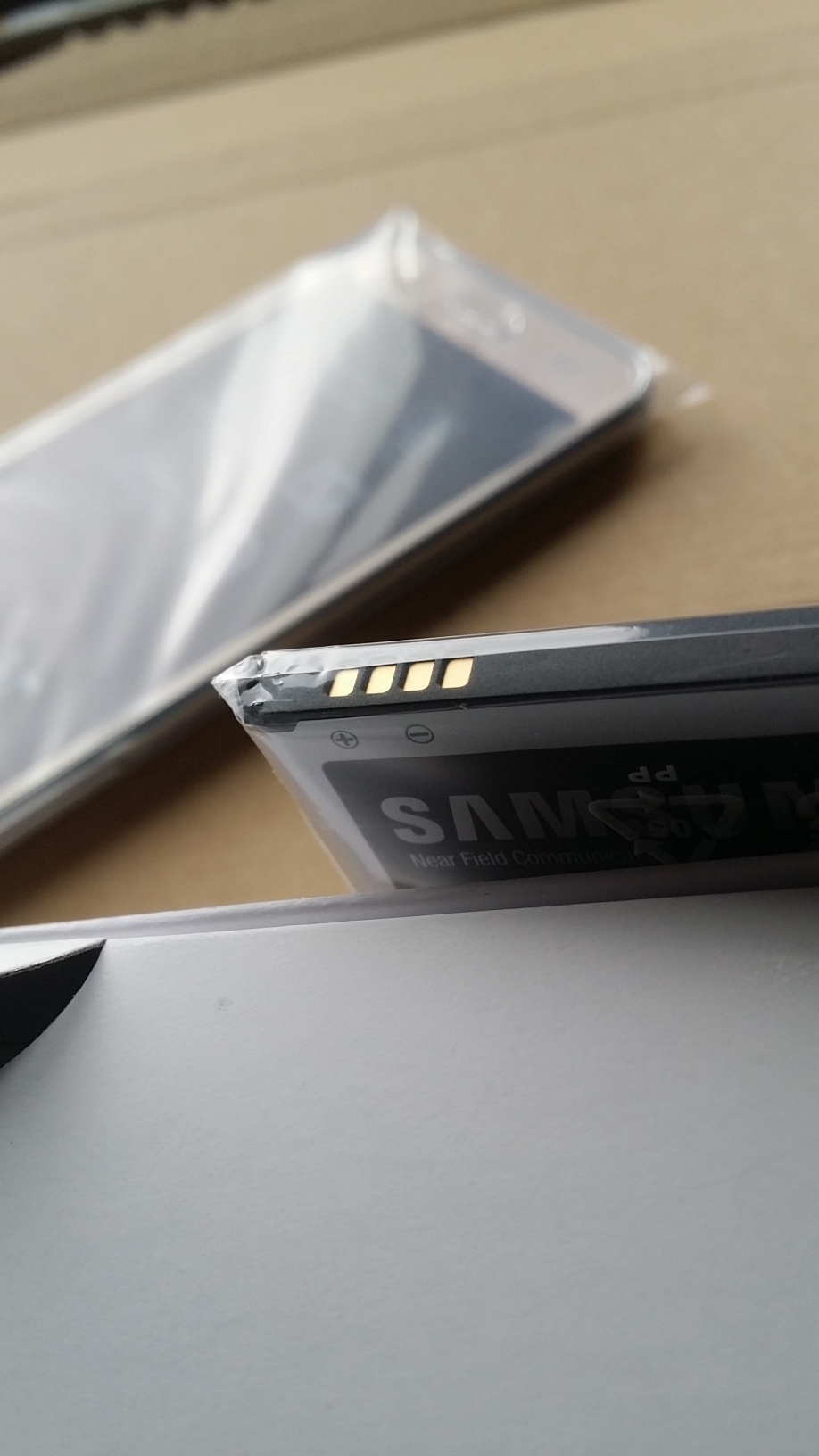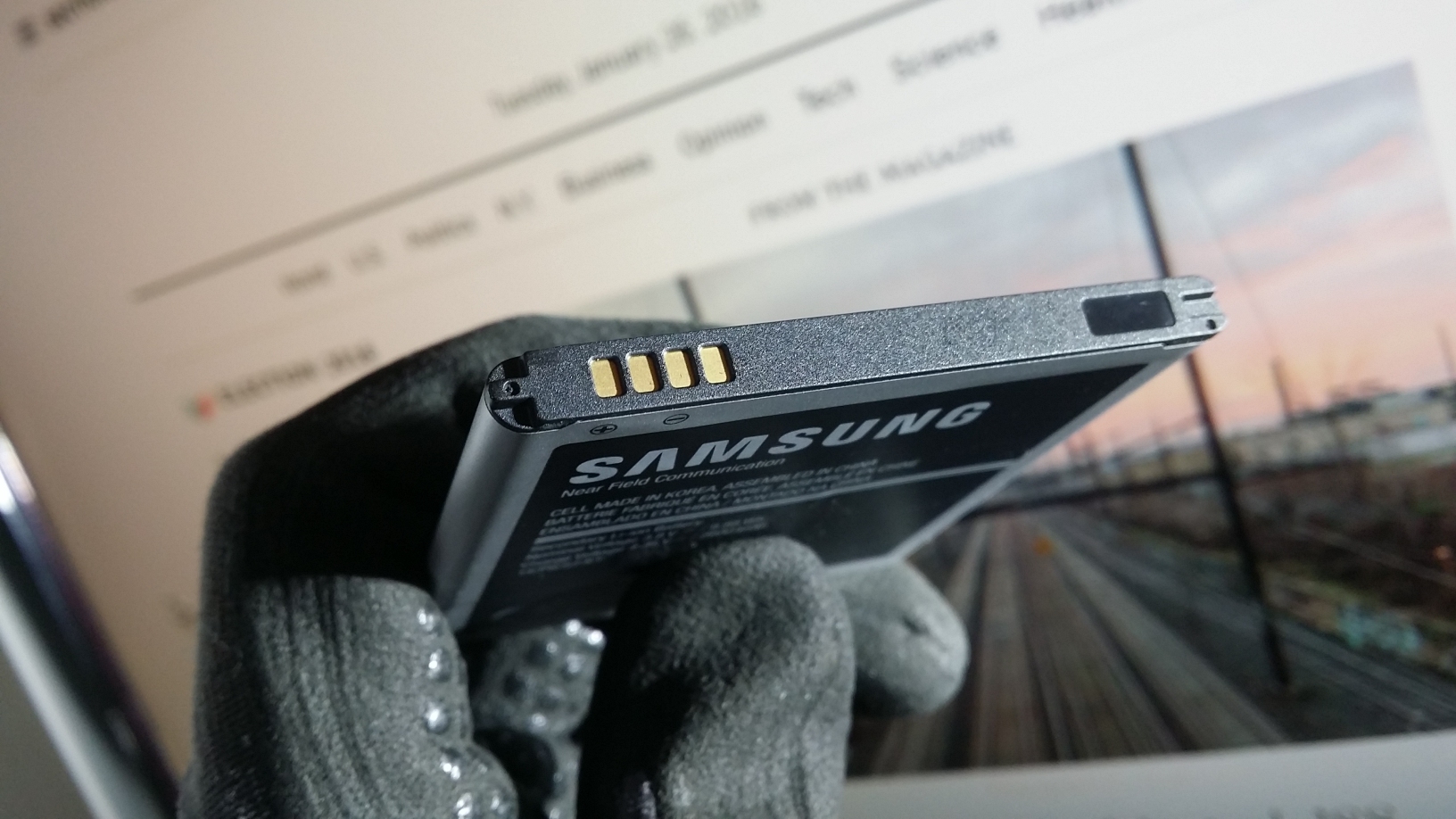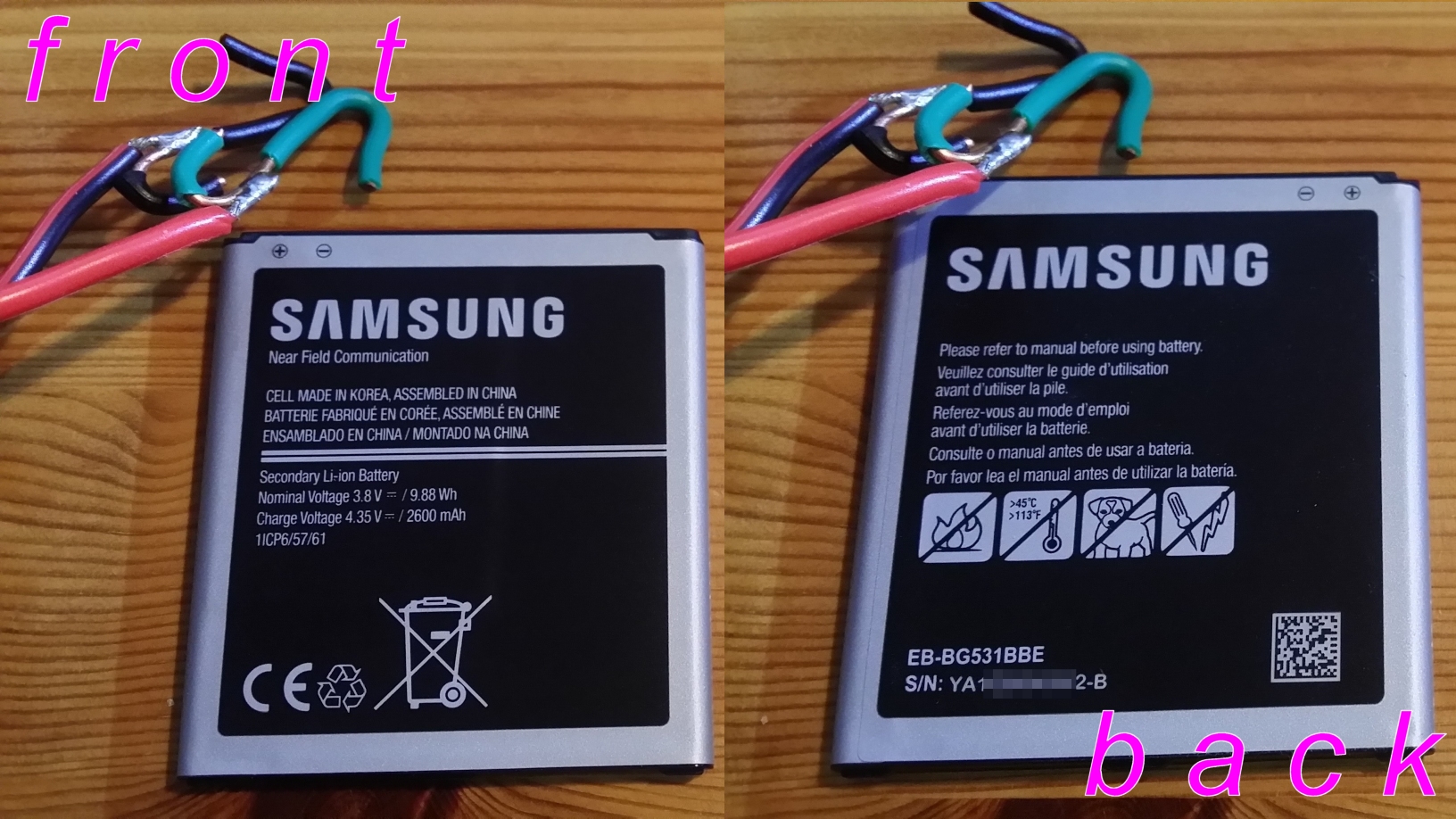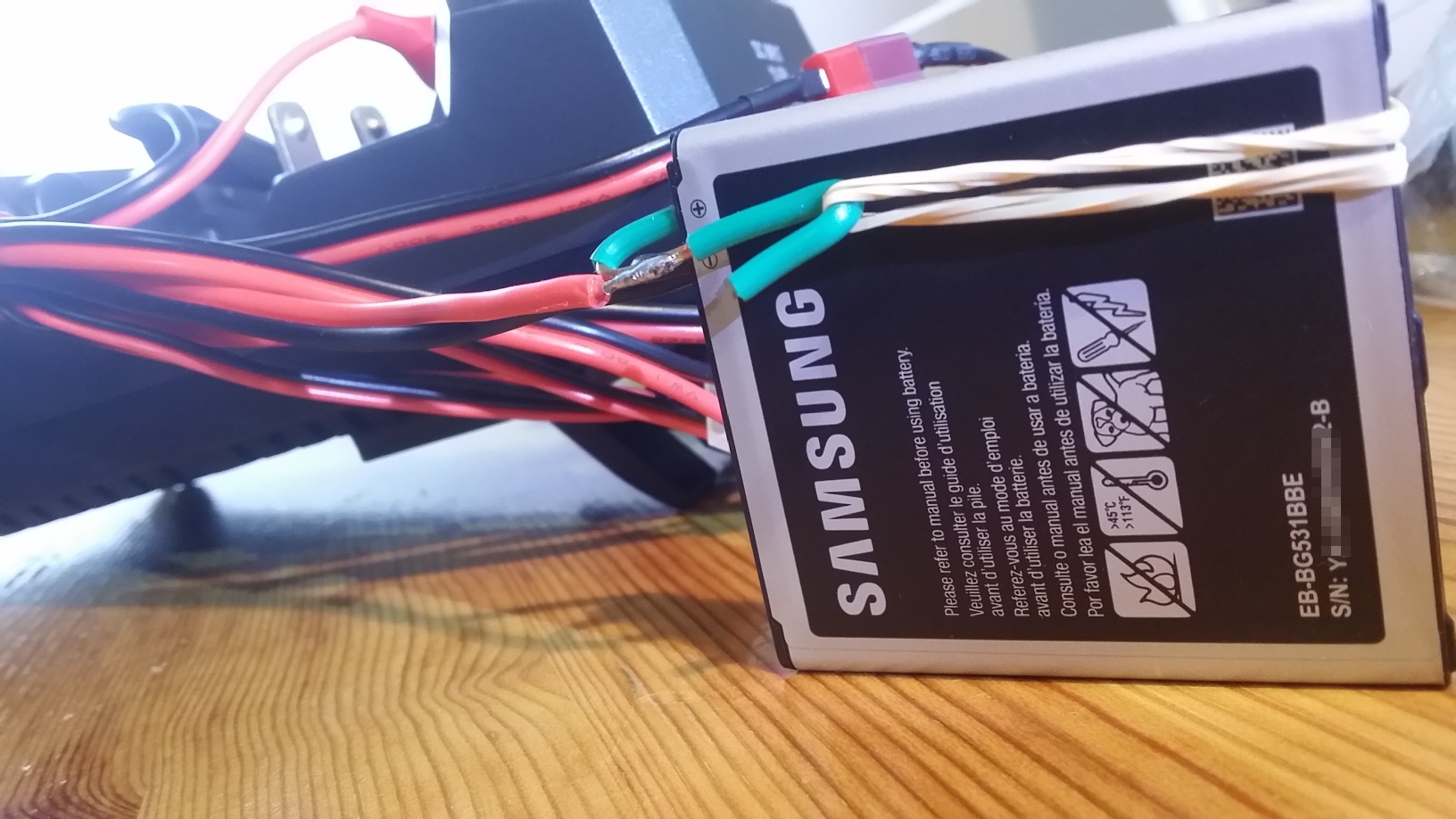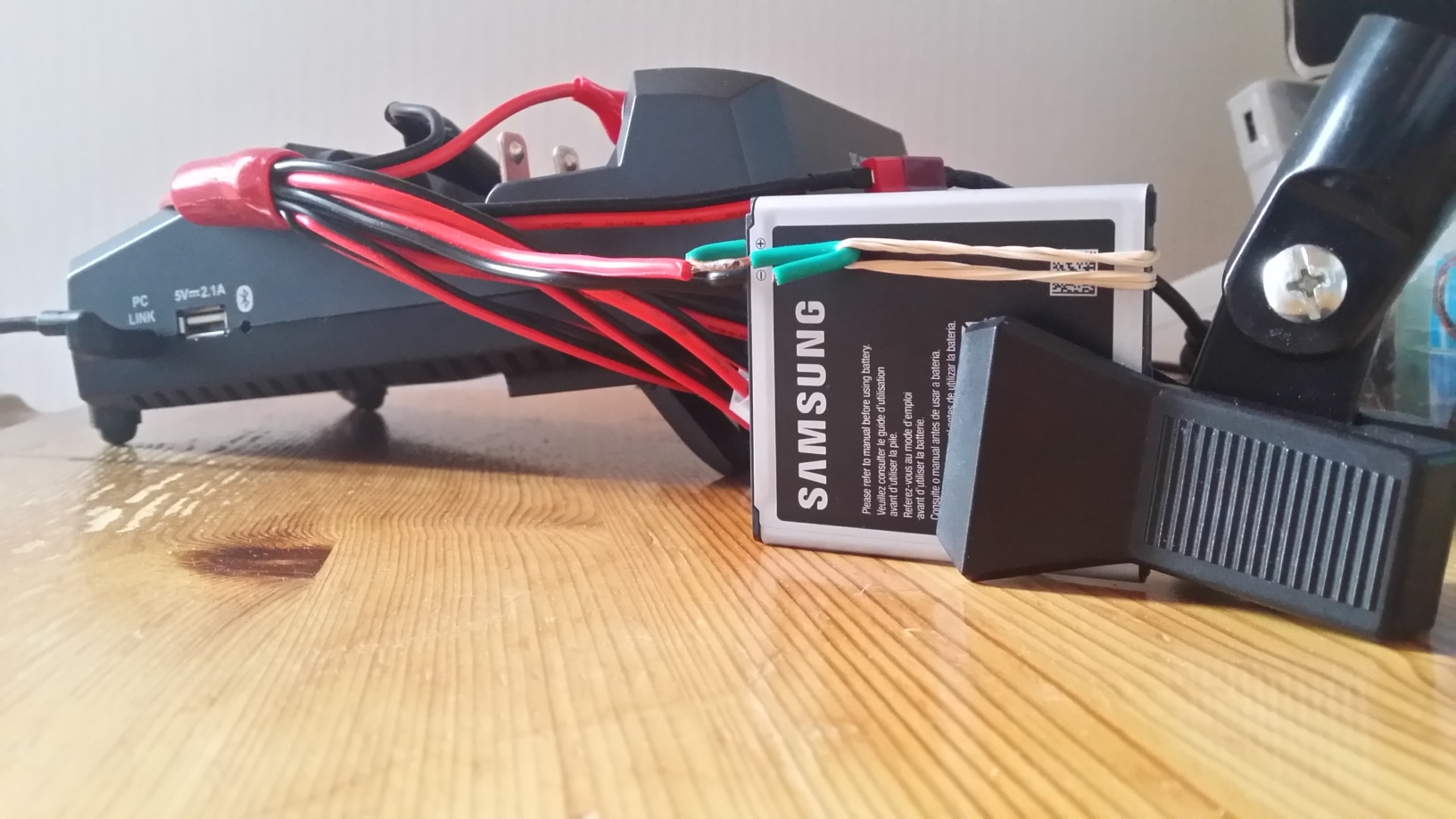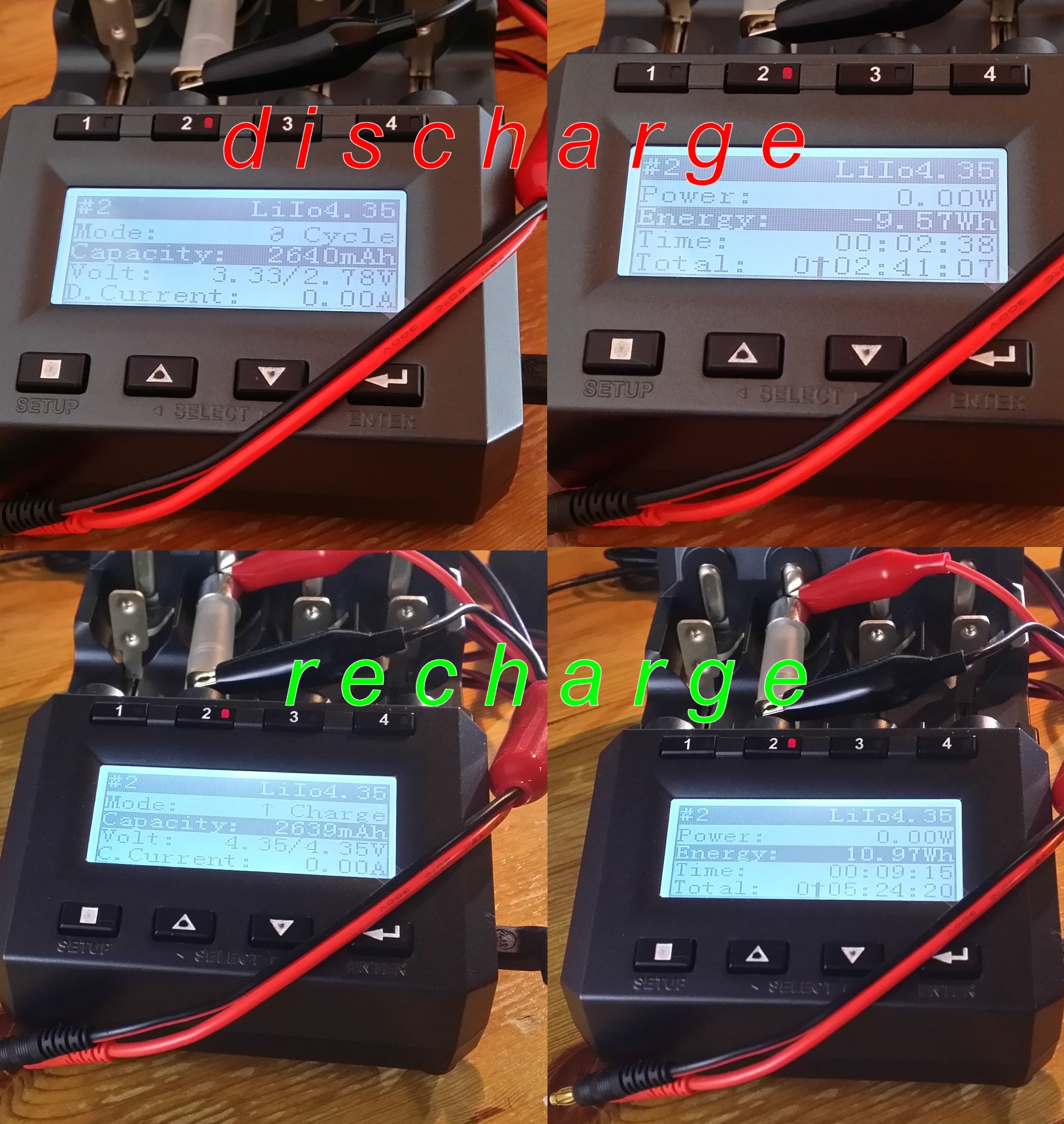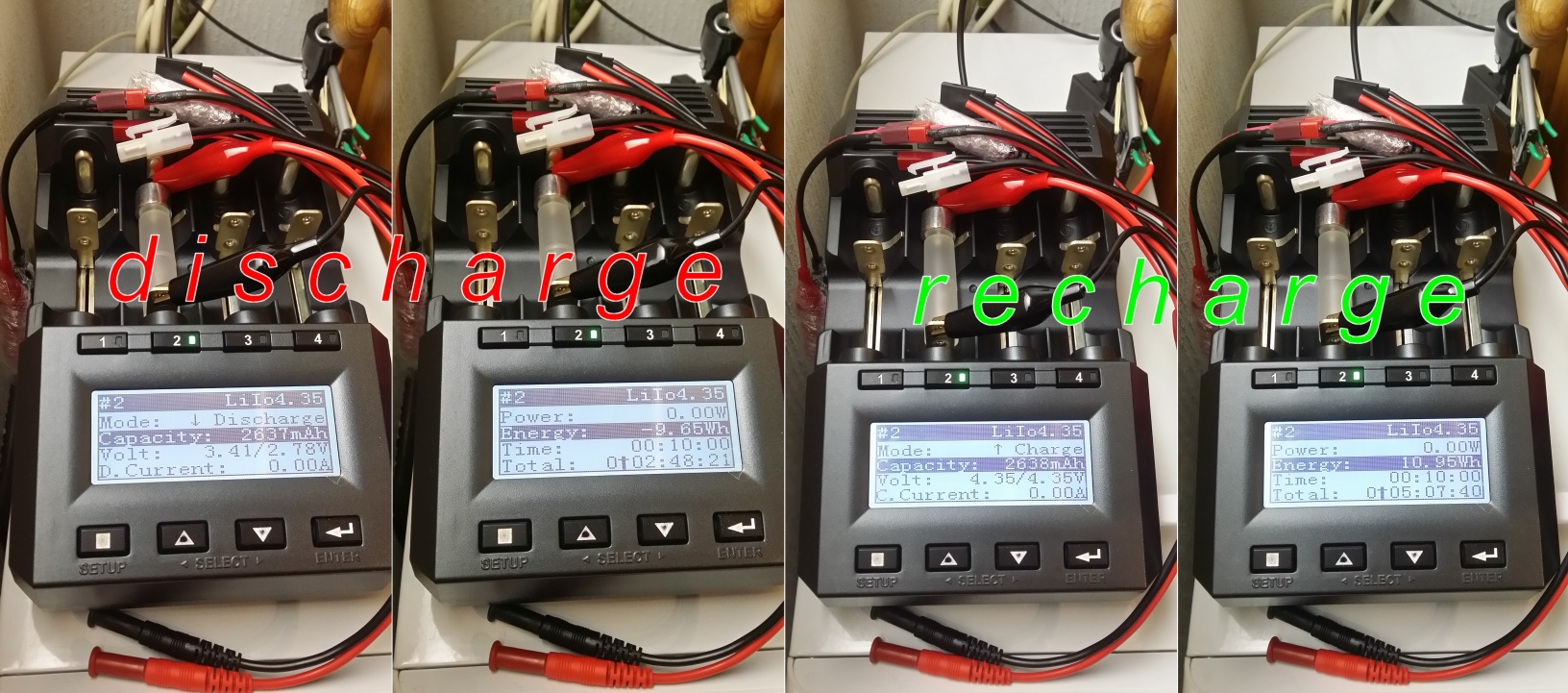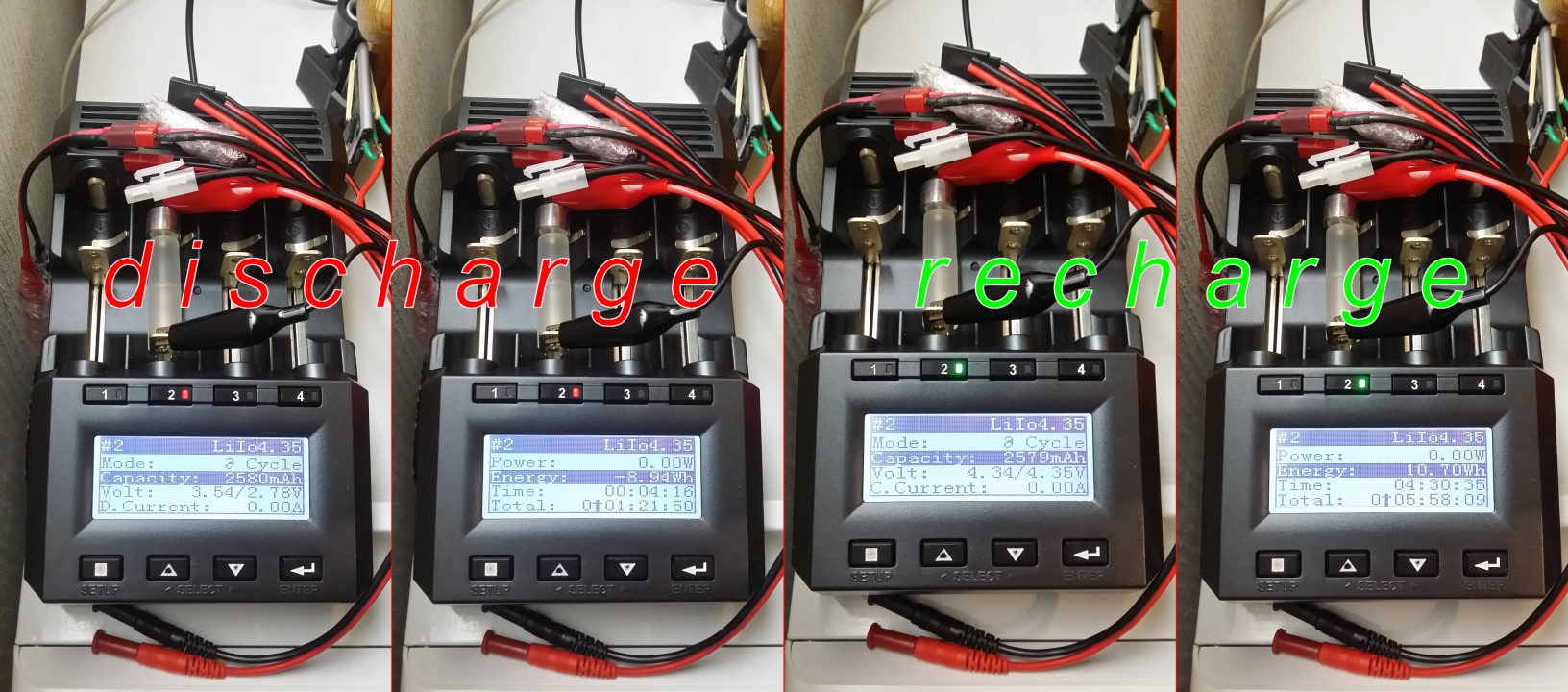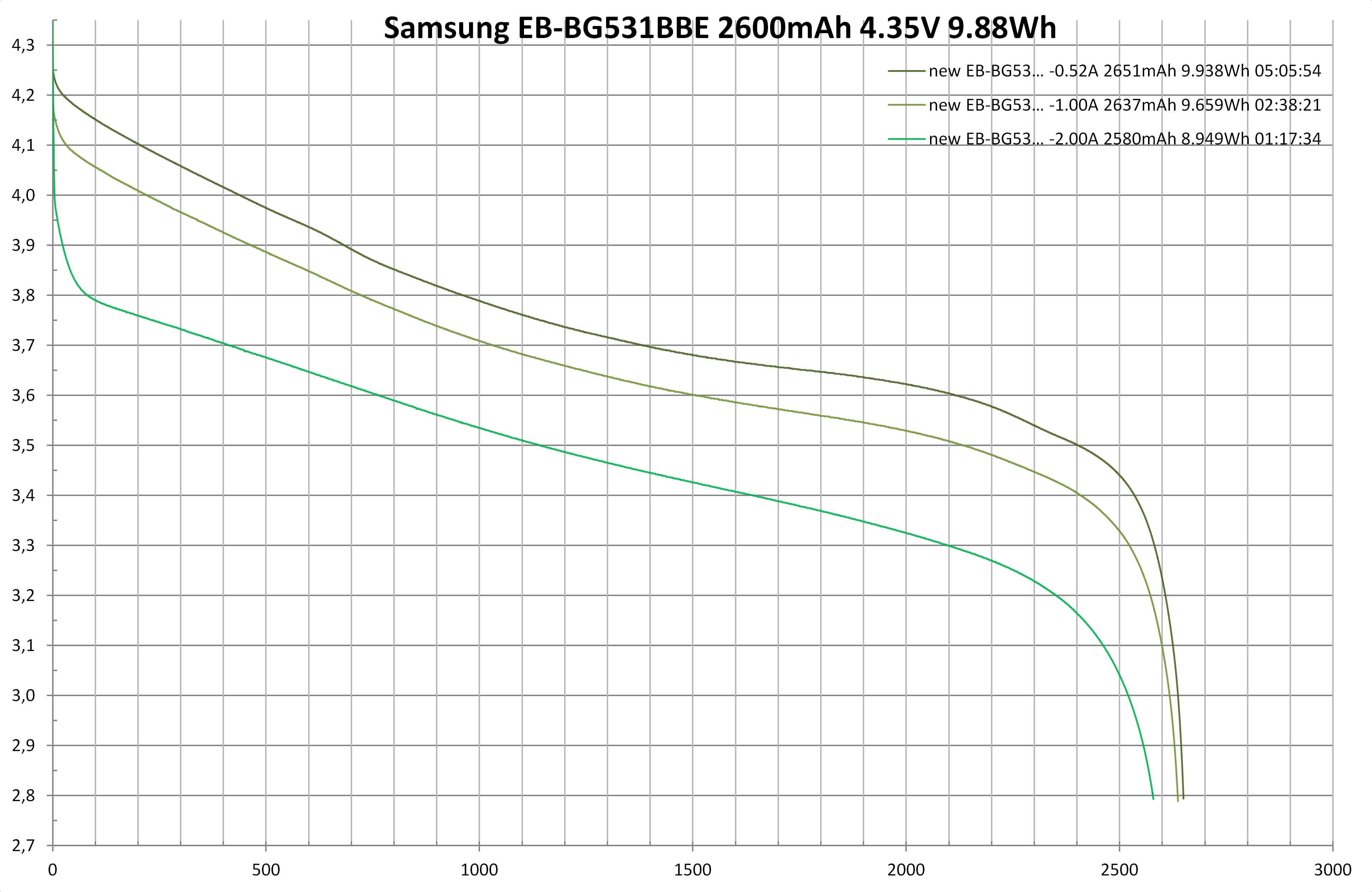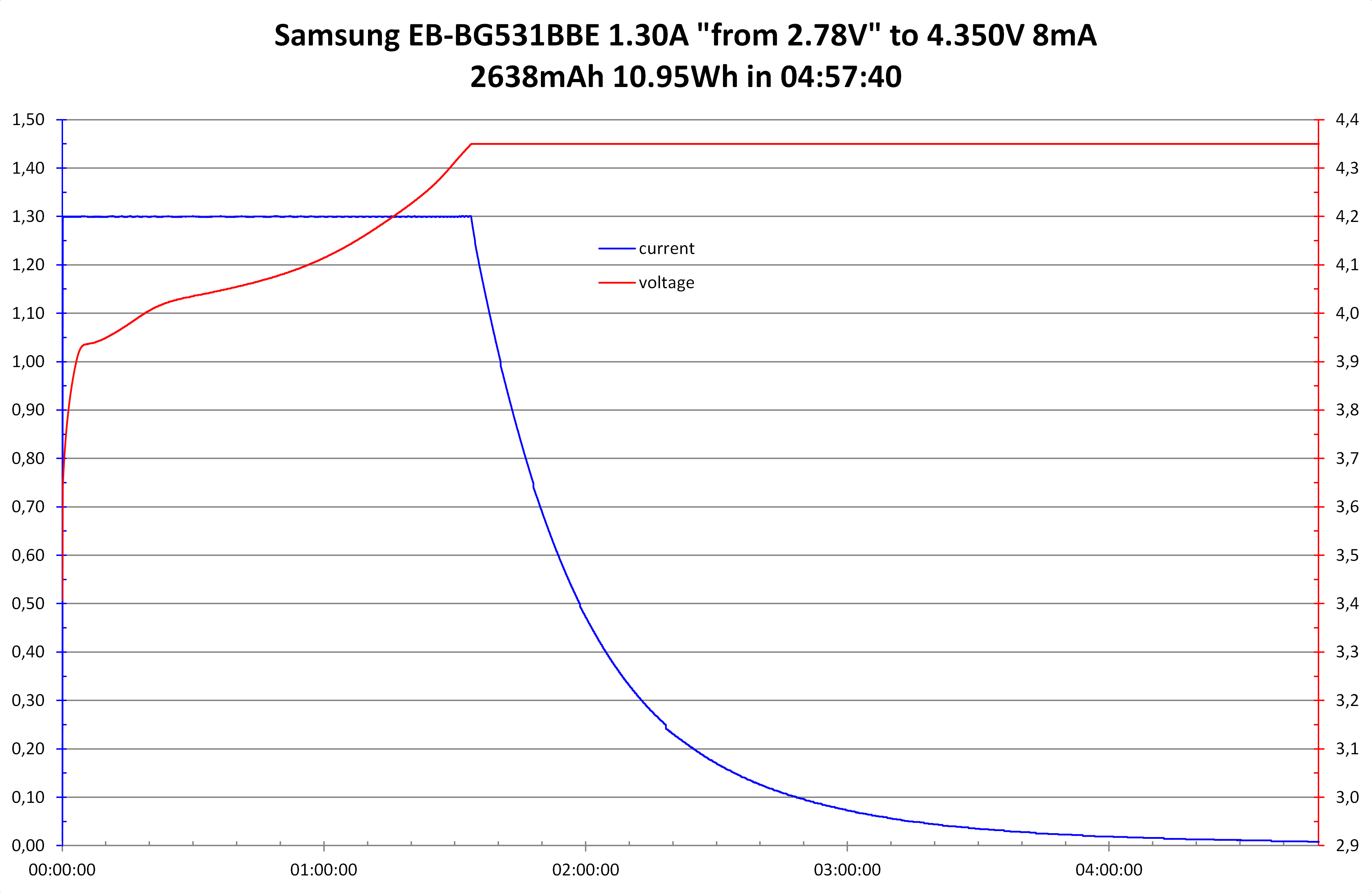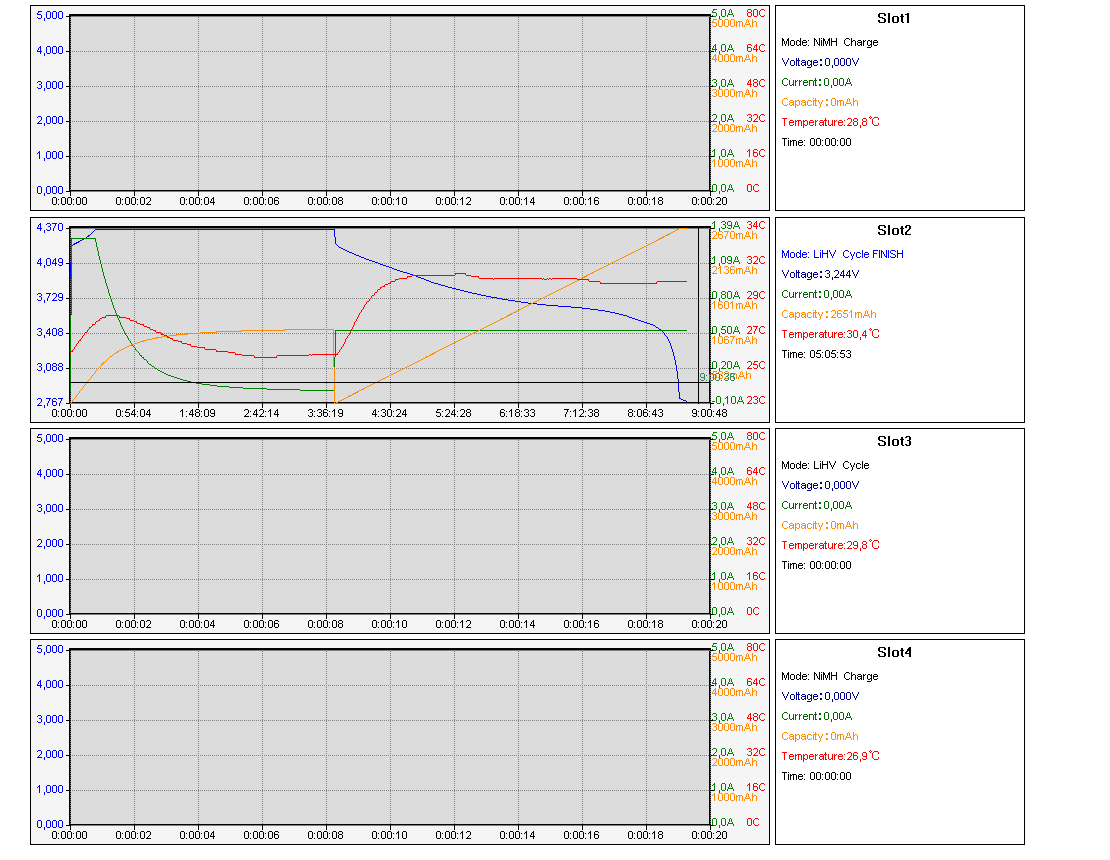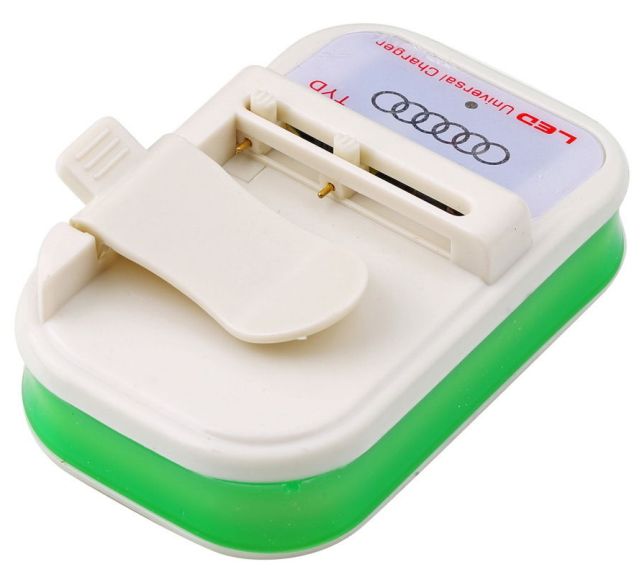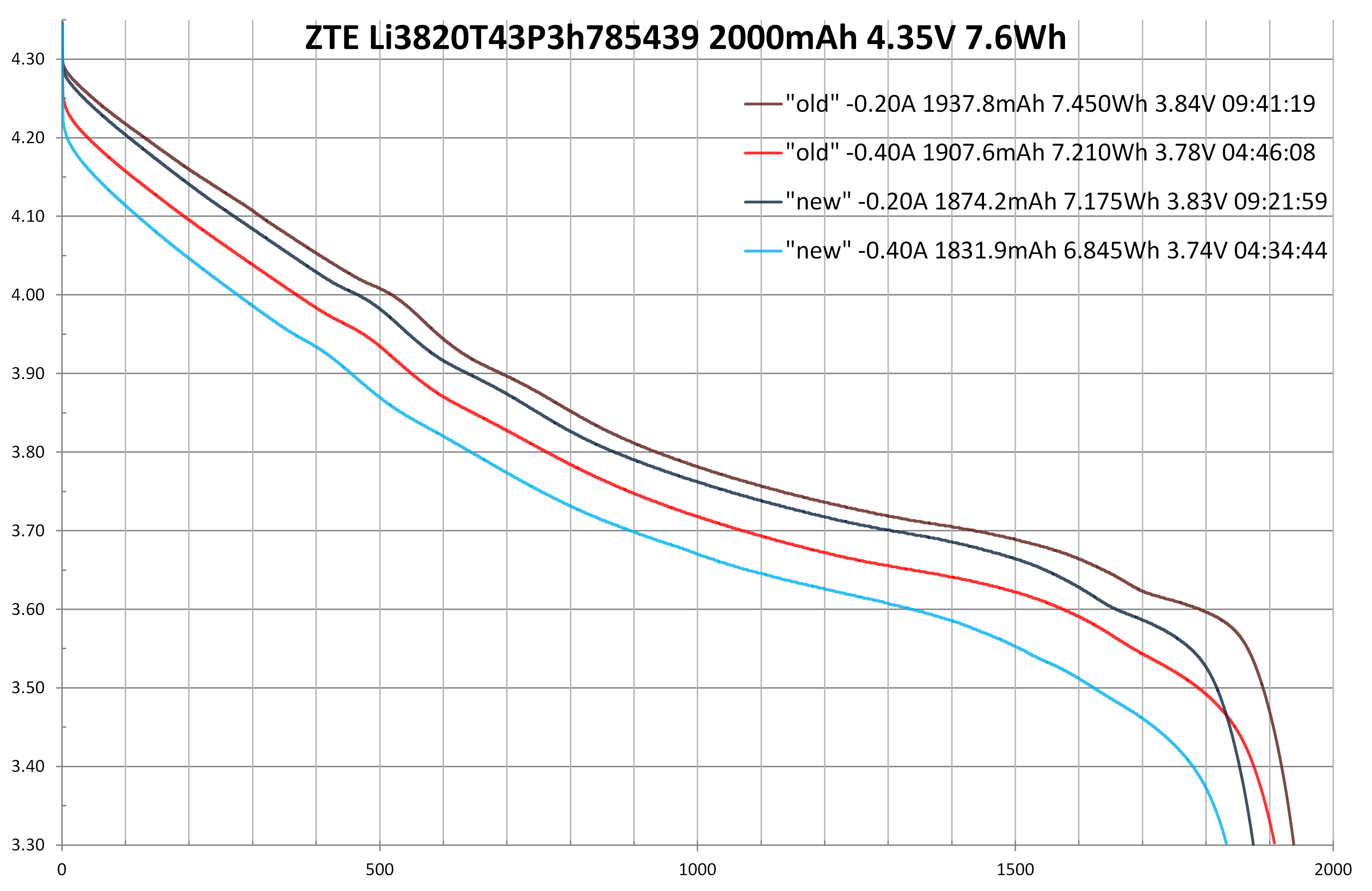kreisl
Flashlight Enthusiast
- Joined
- Jul 5, 2012
- Messages
- 2,241
Hello everyone,
let's share some test results (test data, or charts created by PCLS/DEX/LVS/Excel/etc) of our 3.6V 3.7V 3.8V rechargeable batteries at home, i.e. single cell non-cylindrical lithium-ion (or single cell lithium-polymer) batteries like the one used in our smartphones. It's hard to source official public pdf datasheets for such batteries and i haven't seen many internet reviews/tests of smartphone batteries. Btw my el cheapo USB tester gives comparable results but how fun is that?
My old phone battery (Samsung B800BC 3200mAh, hardly in use for 12 months) has been cra**ing out on me and before i substitute my spare battery (Samsung B800BE 3200mAh, never used) i wanted to compare their performance visually. I've been working with various battery analyzers (Imax B6, iCharger, B6 Mini, EBC-A, EBD-Mini, CBA, MH-C9K) and today i am showing how the MC3K could be misused for this purpose :devil: with a typical charging harness from the RC hobby folks.
for this purpose :devil: with a typical charging harness from the RC hobby folks.
WARNING: When handling a charging harness, there is imminent danger of short-circuiting the battery! As soon as a battery is connected, all wires and terminals of the harness are hot. This is especially true for the banana plugs. So DO NOT copycat the below setup, it's for instructional purpose only
Let's get started. I took three silly photos which should prove that my spare battery was new, unopened, untouched, unused. Interestingly the 4 mini contacts had traces of usage, maybe from QC ex factory:
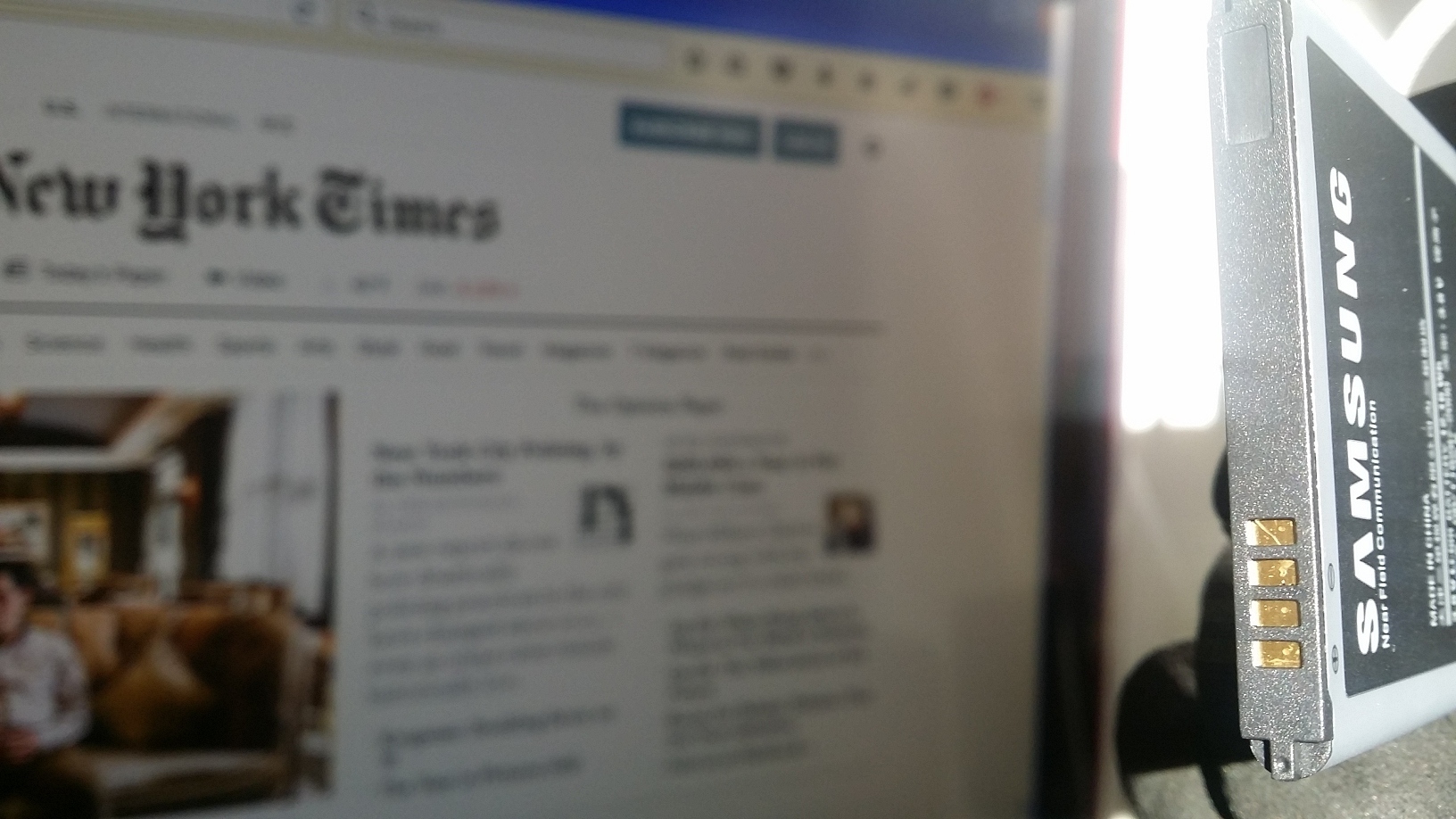
This is what my new battery looks like:
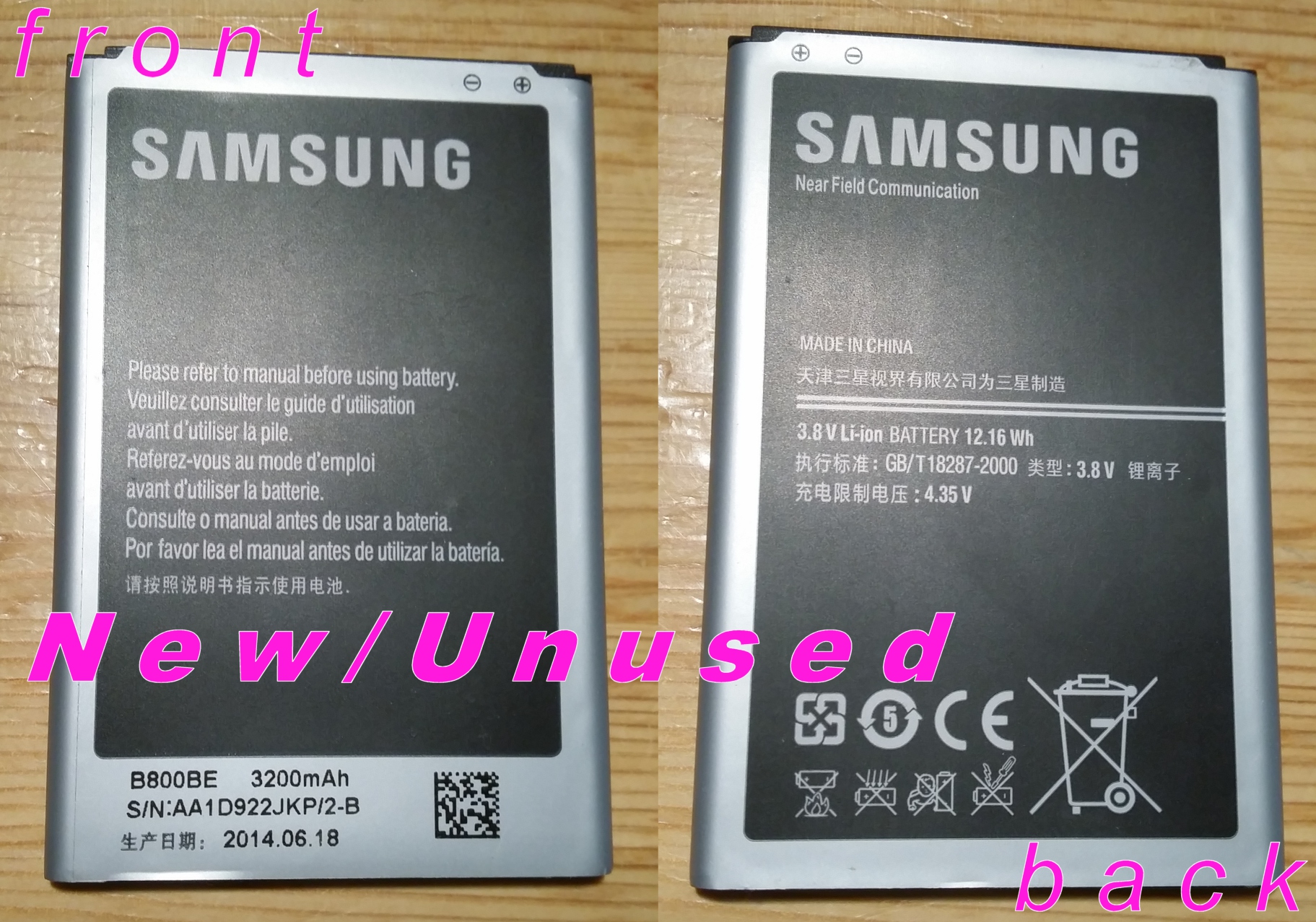
and what my old battery looks like:
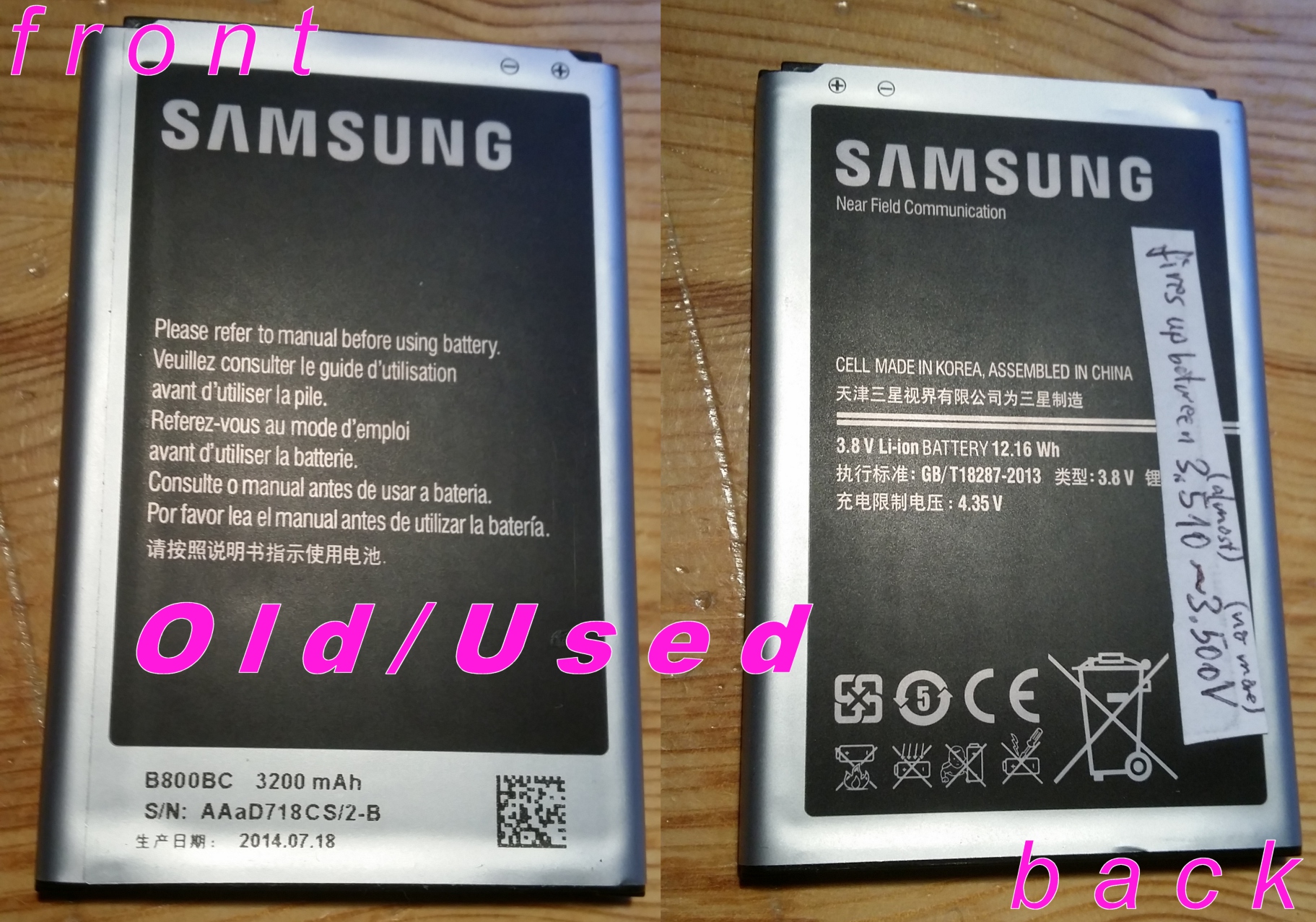
The nominal specs are the same, 3200mAh capacity, 12.16Wh energy, 4.35V Samsung, cell made in Korea. Model name B800BC versus B800BE shouldn't make a difference in testing, the letters could indicate sales or NFC region or whatnot, i dunno. The battery size dimensions is approximately (mm) 80.1 x 52.9 x 5.4.
I use the crocodile alligator clips to connect the harness with the charger. For the positive terminal a conductive spacer helps with the grip:
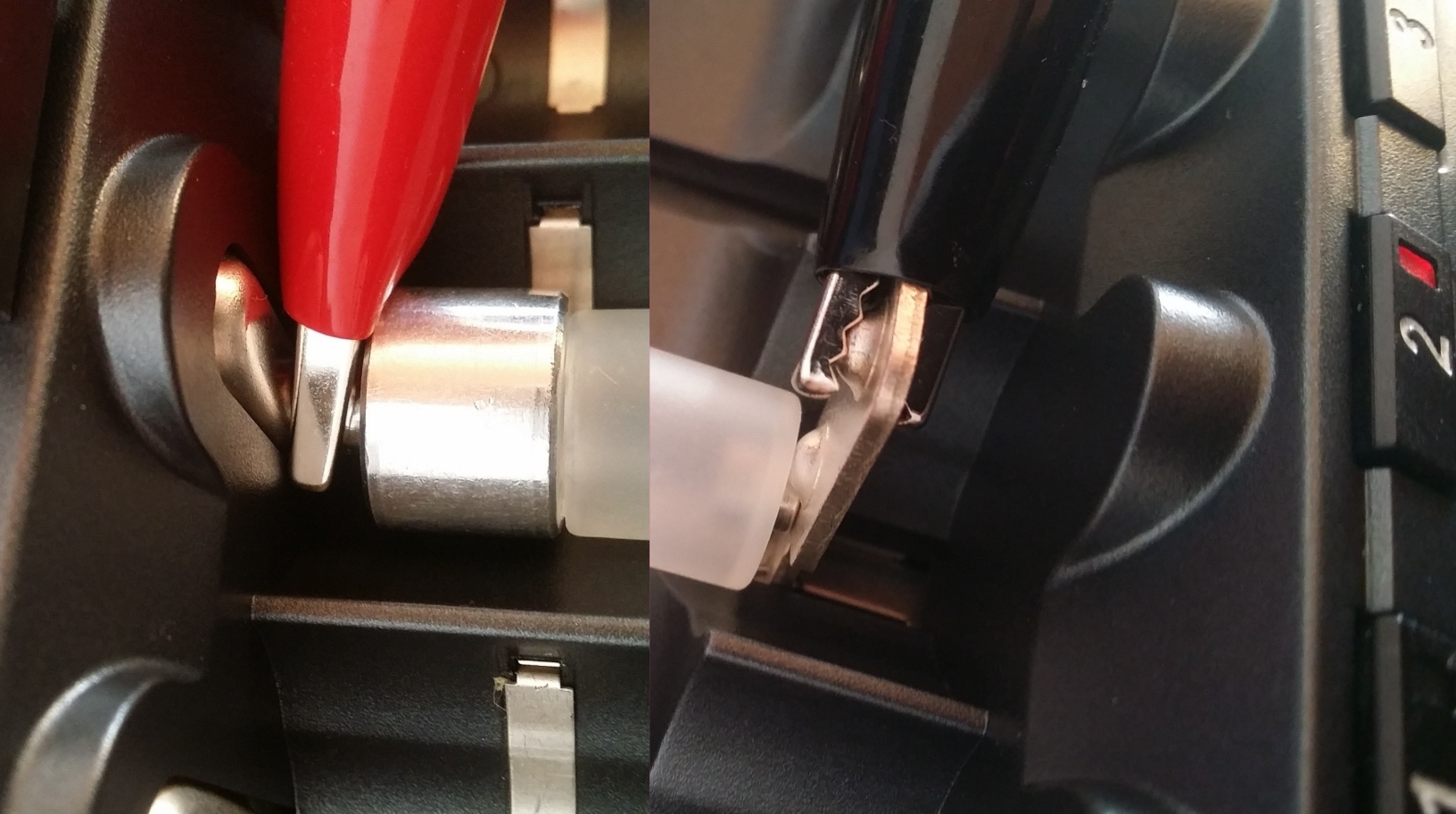
The battery has to be placed next to the charger, "external". Maybe standing in an upright position:

Or maybe lying on the side edge without a holder or support:
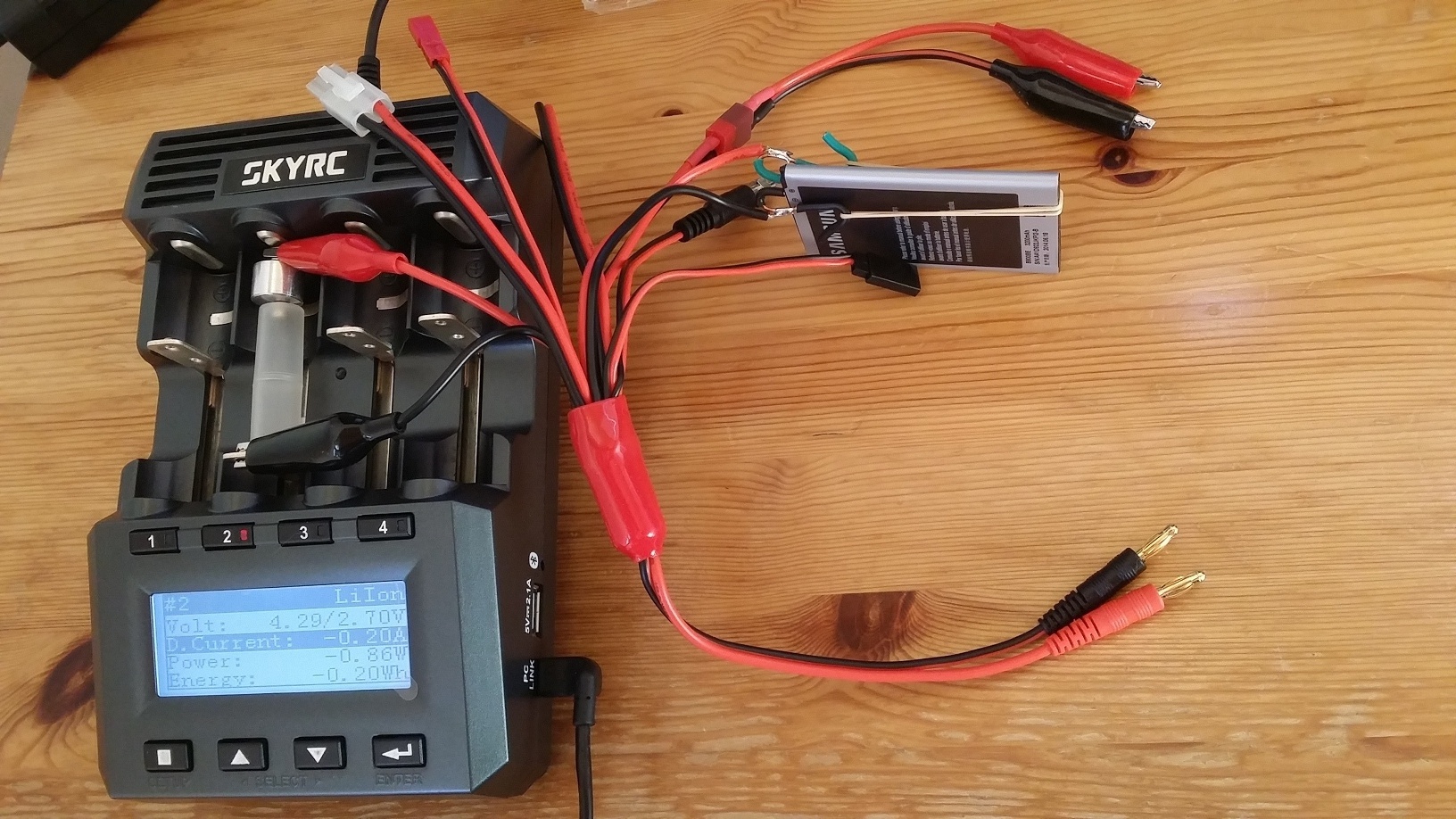
Or with some clamp or holder:

I don't like the upright standing position. It exerts too much stress on the solder joint, see the kink at the black wire terminal:

The hooks have more natural access to the battery lying on the the side edge:
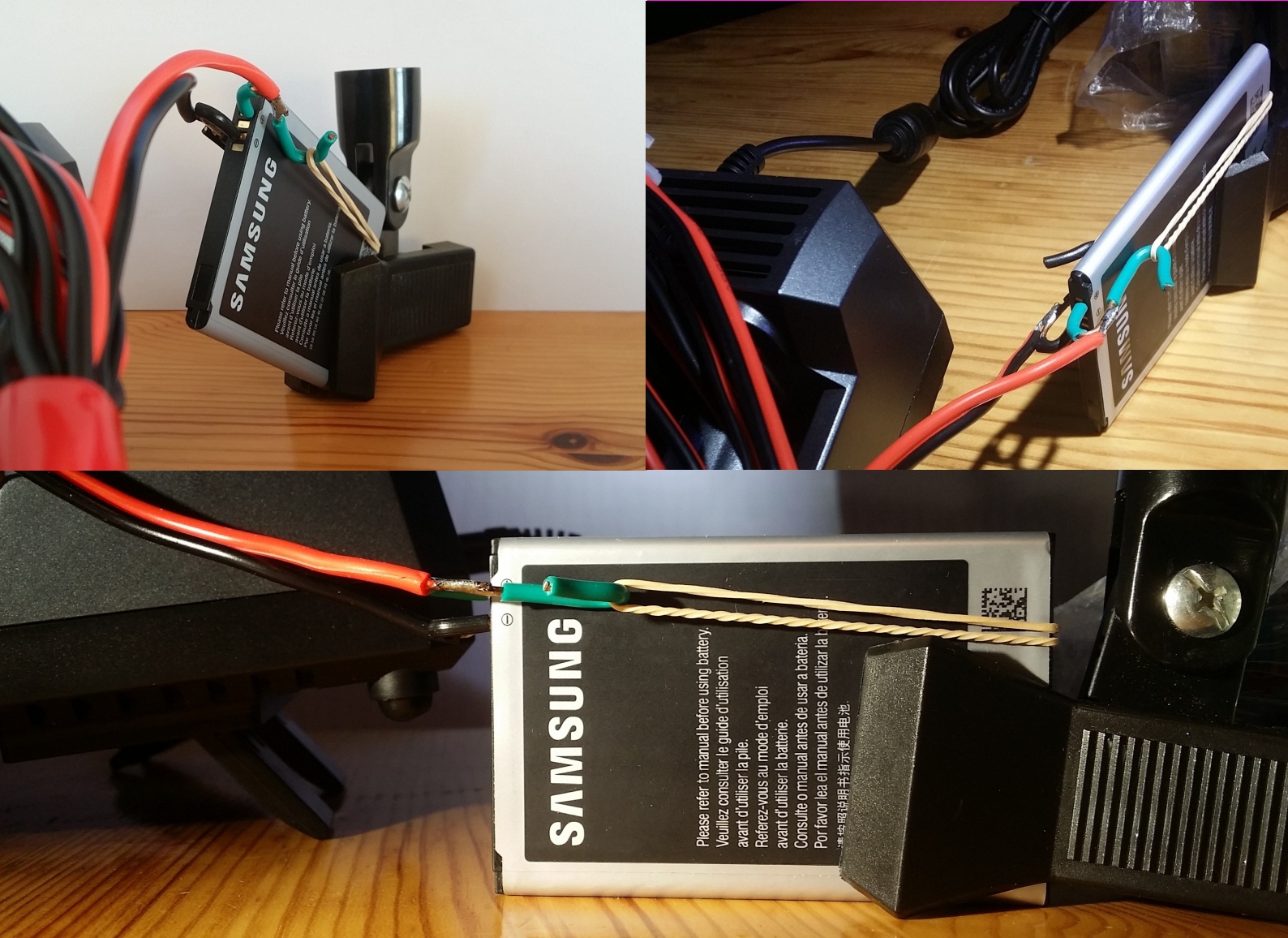
Here a profile shot from bird's eye view:
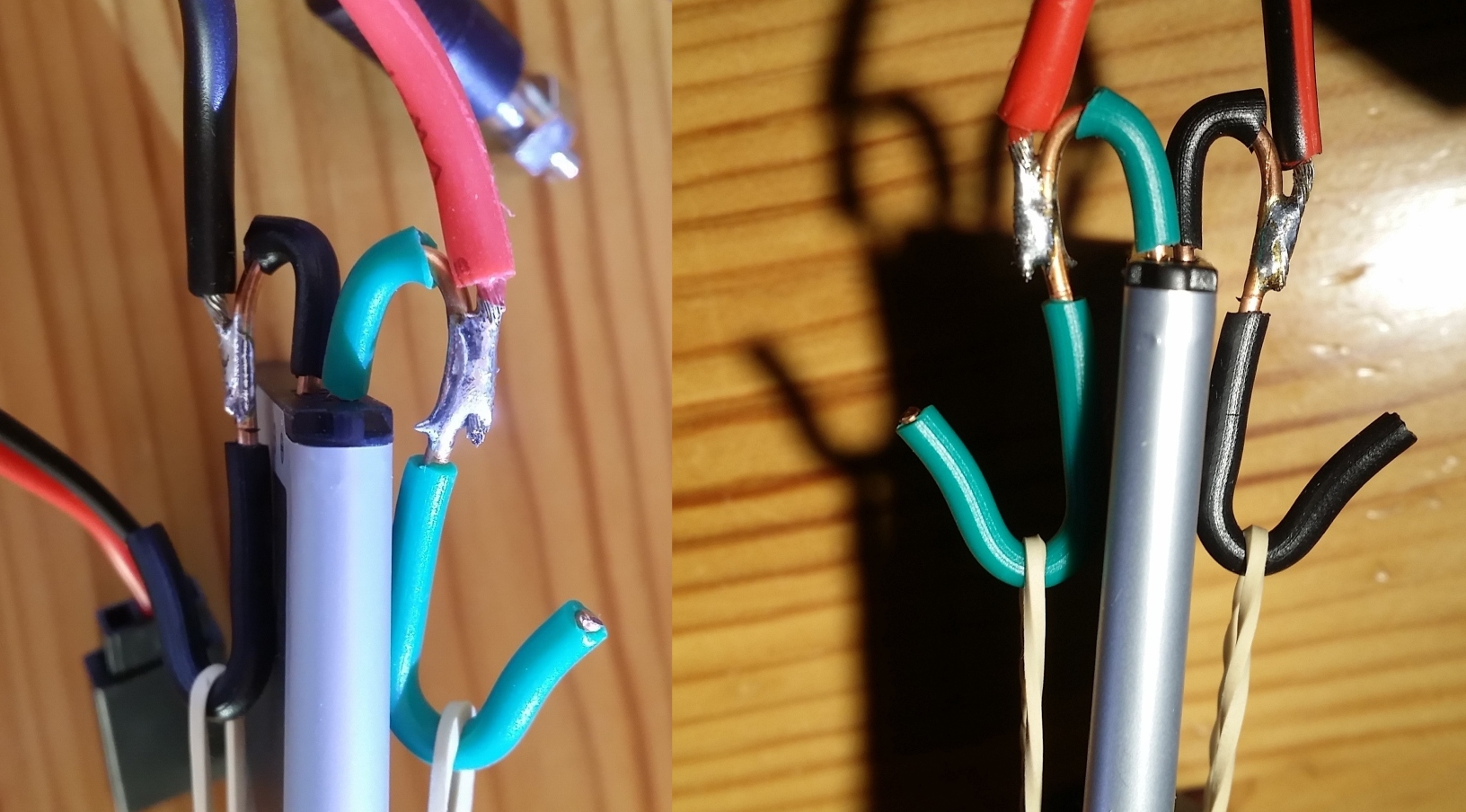
And again some close-up views:
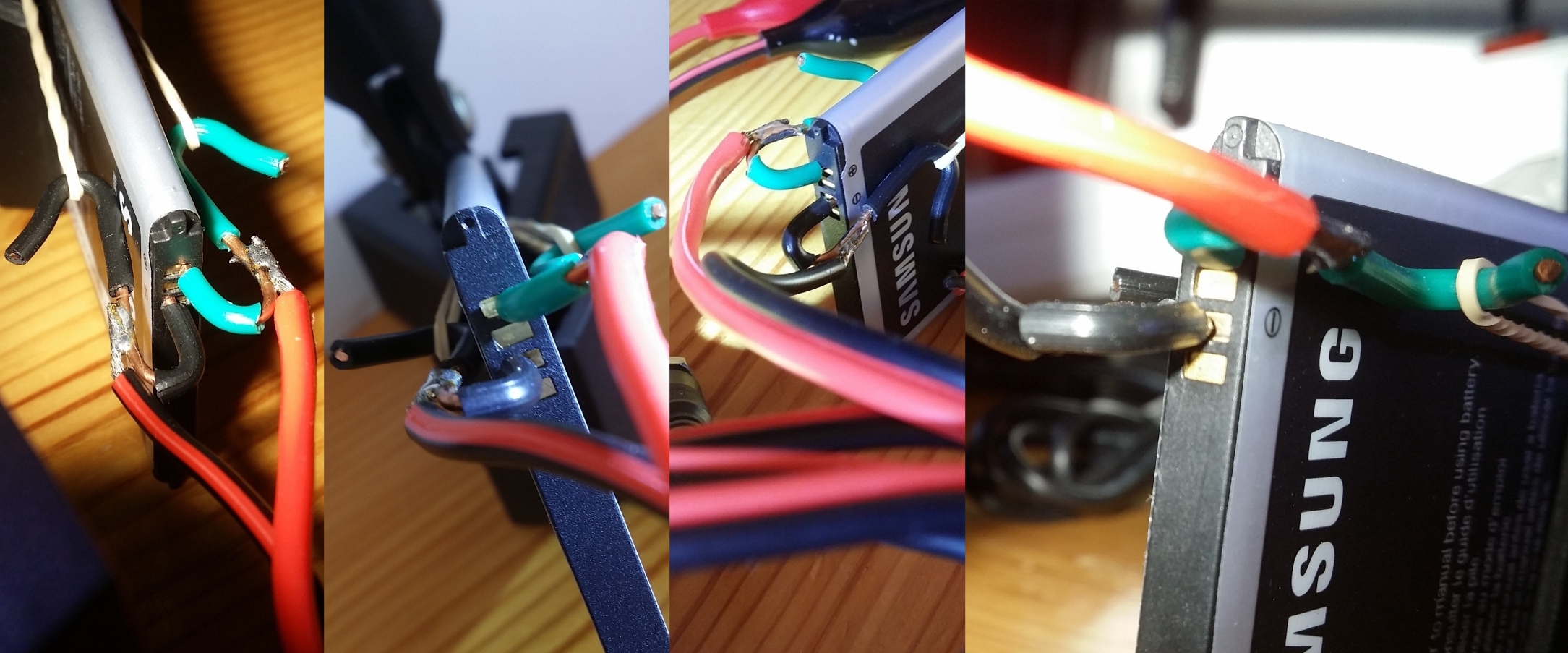
Btw credits for the hooking idea goes to a geman boardie, i stumbled upon it last December and immediately thought of testing it on my new mc3k unit.
The following pic shows my original Samsung 4.35V cradle charger and the USB tester. My new battery gets charged to 4.360V in the cradle charger, whereas the old battery somehow does not get charged higher than say 4.260V: the cradle charger and the phone's internal charger terminate charging at 4.22V, and the mc3k would return a Connection Break error at some late point during the CV-phase ("0 Volt"). Charging the old battery with 4.260V TARGET VOLT would finish without error. Maybe the old battery has some confused overcharge protection circuit PCB? I also get a Connection Break error ("0 Volt") with the new battery when discharging it lower than 2.775V, especially with a low discharging current like -0.20A. I like my gadgets in white:

The following Excel chart shows the capacity graphs in the traditional voltage-vs-capacity format in high resolution high accuracy. With this chart at hand, we can make three observations: 1) the old battery s*cks compared to the new battery, 2) the new battery is still far away from the nominal 3200mAh capacity, 3) the graphs look legit and beautiful and much finer and higher resolved than by any other of the aforementioned battery analyzers!
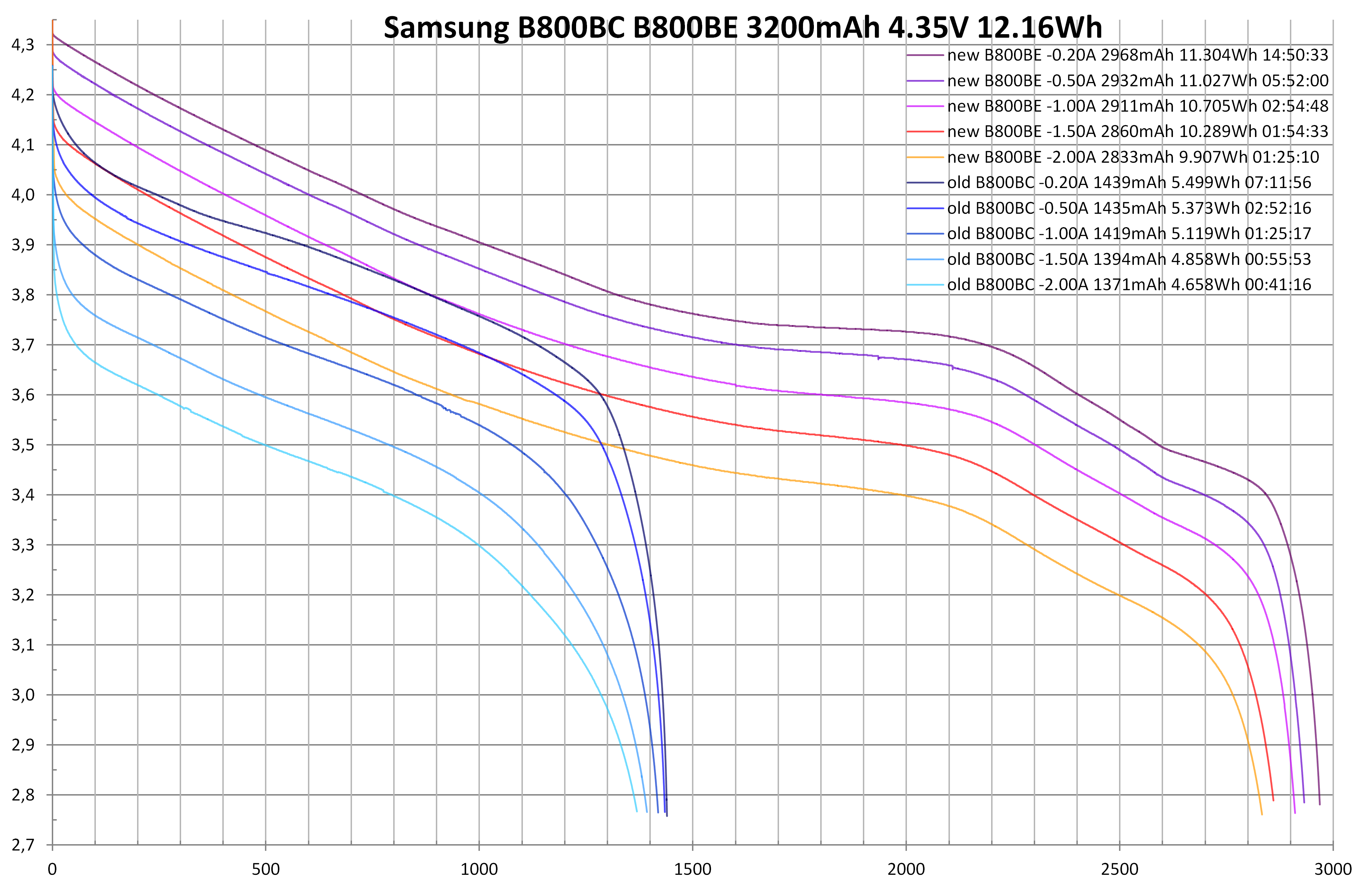
I logged lots of discharge cycles with the mc3k and or PCLS. In some runs the PCLS log was missing the last 4-6sec of data, making the log have an incomplete ending. Might be a bug in PCLS but am not sure if it can be remedied. PCLS logs the voltage and current with 1mV and 1mA resolution but capacity only with 1mAh resolution because of the digits space limitation on the LCD. Internally the device calculates the mAh's correctly with higher frequency and resolution as verified by rough calculation, 0.20*1000*(14*3600+50*60+33)/3600=2968.5mAh, and by Excel integral method:

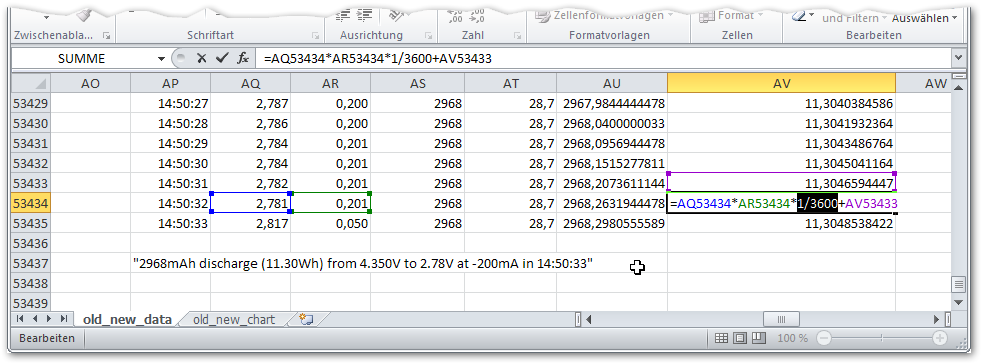
I recharged the battery with the Samsung cradle charger or with the mc3k, usually without logging in PCLS. Here some arbitrary charge log of the new battery:
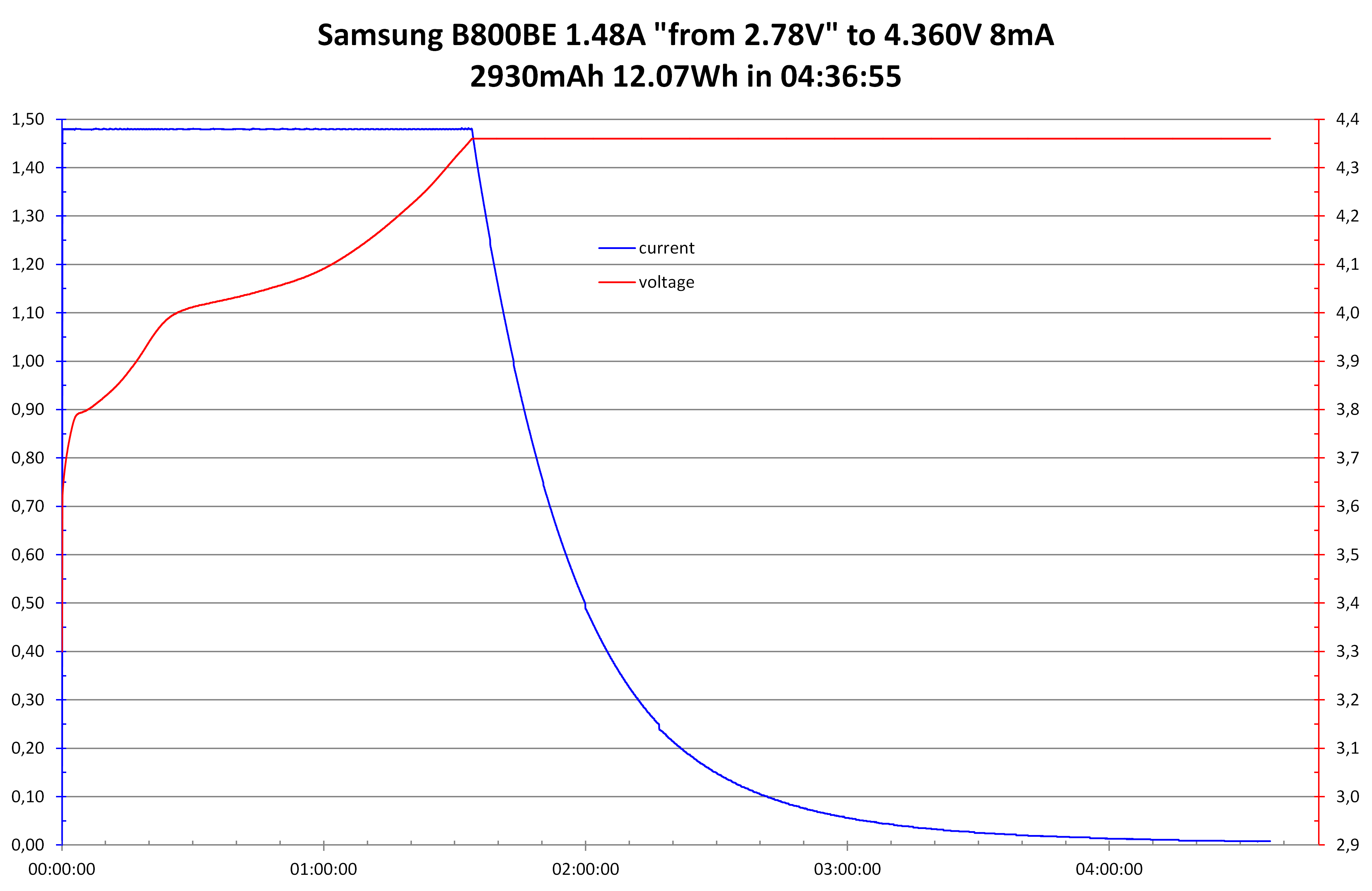
And of the old battery, on the same time frame:

The physical law "Discharged capacity = Charged capacity" was especially true for the old battery. Here the complete set of runs in chronological order over the past 2 weeks, the actual table.txt file i've been working with:

That table looks like excessive testing, unnecessarily so you think? Sure. But only repeated test runs will give us an idea of the consistency, tolerance, variation, or accuracy of the results. In future we will know what to expect, if we redid a particular test run and were unhappy with the result.
On a side note, the smartphone discharges the battery to 3.51V only, not further down; a battery with 3.51V offline voltage hardly gets the phone to show any sign of vital reaction when the on/off button is pressed. A battery with 3.50V offline voltage makes the phone look totally dead. So for practical purposes one could look at the capacity ("Discharged capacity = Charged capacity") between 3.51 and 4.35V only and use the USB meter to analyze the charged capacity. Yes the above table.txt showed that the USB meter reading isn't too far off from the mc3k reading. However, even if the USB meter measured capacity very accurately, the readings will still differ notably between recharges because the discharged capacity depends on the phone usage (high current draw vs. low current draw).
If you too have old or new single cell non-cylindrical batteries and want to test them with your battery analyzer, you're welcome to share the results in this thread. It's imho a fun exercise to analyze the battery when it's new/unused and re-analyze it after a couple of months. Me too, i'll definitely keep an eye on the rate of degradation of my new phone battery, which probably costs only 5$ on ebay new, so why bother?
Not bother. It's "most joyful".
EDIT:
2016-03-22 "2537mAh" charge "1.68A" from 3.510V to "100%" in Samsung phone (=4.318V, checked with DMM)
let's share some test results (test data, or charts created by PCLS/DEX/LVS/Excel/etc) of our 3.6V 3.7V 3.8V rechargeable batteries at home, i.e. single cell non-cylindrical lithium-ion (or single cell lithium-polymer) batteries like the one used in our smartphones. It's hard to source official public pdf datasheets for such batteries and i haven't seen many internet reviews/tests of smartphone batteries. Btw my el cheapo USB tester gives comparable results but how fun is that?
My old phone battery (Samsung B800BC 3200mAh, hardly in use for 12 months) has been cra**ing out on me and before i substitute my spare battery (Samsung B800BE 3200mAh, never used) i wanted to compare their performance visually. I've been working with various battery analyzers (Imax B6, iCharger, B6 Mini, EBC-A, EBD-Mini, CBA, MH-C9K) and today i am showing how the MC3K could be misused
 for this purpose :devil: with a typical charging harness from the RC hobby folks.
for this purpose :devil: with a typical charging harness from the RC hobby folks.WARNING: When handling a charging harness, there is imminent danger of short-circuiting the battery! As soon as a battery is connected, all wires and terminals of the harness are hot. This is especially true for the banana plugs. So DO NOT copycat the below setup, it's for instructional purpose only

Let's get started. I took three silly photos which should prove that my spare battery was new, unopened, untouched, unused. Interestingly the 4 mini contacts had traces of usage, maybe from QC ex factory:

This is what my new battery looks like:

and what my old battery looks like:

The nominal specs are the same, 3200mAh capacity, 12.16Wh energy, 4.35V Samsung, cell made in Korea. Model name B800BC versus B800BE shouldn't make a difference in testing, the letters could indicate sales or NFC region or whatnot, i dunno. The battery size dimensions is approximately (mm) 80.1 x 52.9 x 5.4.
I use the crocodile alligator clips to connect the harness with the charger. For the positive terminal a conductive spacer helps with the grip:

The battery has to be placed next to the charger, "external". Maybe standing in an upright position:

Or maybe lying on the side edge without a holder or support:

Or with some clamp or holder:

I don't like the upright standing position. It exerts too much stress on the solder joint, see the kink at the black wire terminal:

The hooks have more natural access to the battery lying on the the side edge:

Here a profile shot from bird's eye view:

And again some close-up views:

Btw credits for the hooking idea goes to a geman boardie, i stumbled upon it last December and immediately thought of testing it on my new mc3k unit.
The following pic shows my original Samsung 4.35V cradle charger and the USB tester. My new battery gets charged to 4.360V in the cradle charger, whereas the old battery somehow does not get charged higher than say 4.260V: the cradle charger and the phone's internal charger terminate charging at 4.22V, and the mc3k would return a Connection Break error at some late point during the CV-phase ("0 Volt"). Charging the old battery with 4.260V TARGET VOLT would finish without error. Maybe the old battery has some confused overcharge protection circuit PCB? I also get a Connection Break error ("0 Volt") with the new battery when discharging it lower than 2.775V, especially with a low discharging current like -0.20A. I like my gadgets in white:

The following Excel chart shows the capacity graphs in the traditional voltage-vs-capacity format in high resolution high accuracy. With this chart at hand, we can make three observations: 1) the old battery s*cks compared to the new battery, 2) the new battery is still far away from the nominal 3200mAh capacity, 3) the graphs look legit and beautiful and much finer and higher resolved than by any other of the aforementioned battery analyzers!

I logged lots of discharge cycles with the mc3k and or PCLS. In some runs the PCLS log was missing the last 4-6sec of data, making the log have an incomplete ending. Might be a bug in PCLS but am not sure if it can be remedied. PCLS logs the voltage and current with 1mV and 1mA resolution but capacity only with 1mAh resolution because of the digits space limitation on the LCD. Internally the device calculates the mAh's correctly with higher frequency and resolution as verified by rough calculation, 0.20*1000*(14*3600+50*60+33)/3600=2968.5mAh, and by Excel integral method:


I recharged the battery with the Samsung cradle charger or with the mc3k, usually without logging in PCLS. Here some arbitrary charge log of the new battery:

And of the old battery, on the same time frame:

The physical law "Discharged capacity = Charged capacity" was especially true for the old battery. Here the complete set of runs in chronological order over the past 2 weeks, the actual table.txt file i've been working with:

That table looks like excessive testing, unnecessarily so you think? Sure. But only repeated test runs will give us an idea of the consistency, tolerance, variation, or accuracy of the results. In future we will know what to expect, if we redid a particular test run and were unhappy with the result.
On a side note, the smartphone discharges the battery to 3.51V only, not further down; a battery with 3.51V offline voltage hardly gets the phone to show any sign of vital reaction when the on/off button is pressed. A battery with 3.50V offline voltage makes the phone look totally dead. So for practical purposes one could look at the capacity ("Discharged capacity = Charged capacity") between 3.51 and 4.35V only and use the USB meter to analyze the charged capacity. Yes the above table.txt showed that the USB meter reading isn't too far off from the mc3k reading. However, even if the USB meter measured capacity very accurately, the readings will still differ notably between recharges because the discharged capacity depends on the phone usage (high current draw vs. low current draw).
If you too have old or new single cell non-cylindrical batteries and want to test them with your battery analyzer, you're welcome to share the results in this thread. It's imho a fun exercise to analyze the battery when it's new/unused and re-analyze it after a couple of months. Me too, i'll definitely keep an eye on the rate of degradation of my new phone battery, which probably costs only 5$ on ebay new, so why bother?
Not bother. It's "most joyful".

EDIT:
2016-03-22 "2537mAh" charge "1.68A" from 3.510V to "100%" in Samsung phone (=4.318V, checked with DMM)
Last edited:


